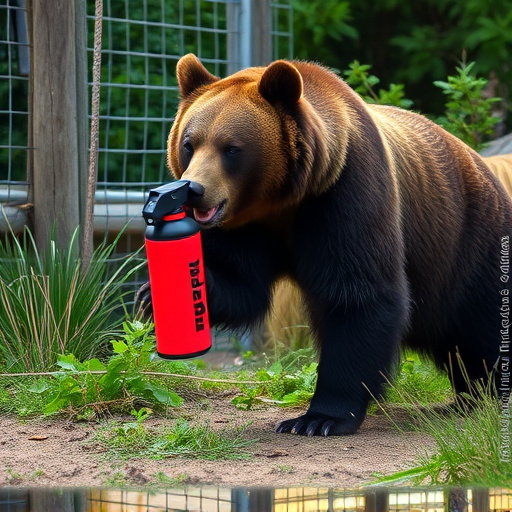Maximizing bear spray safety requires understanding wind direction. Direct the spray at potential bears to reach a maximum range of 30 feet (9 meters), avoiding wind blowing away or behind you. Ideal conditions occur when wind is neither directional, allowing optimal positioning and application techniques. Environmental factors like humidity, temperature, and weather patterns also significantly impact bear spray safety. Practicing aiming strategies and understanding these variables ensures effective deterrence during encounters in bear country.
“Enhance your outdoor safety with a comprehensive guide on bear deterrent spray range and optimal protection. Discover the key factors that influence the effectiveness of bear spray, including wind direction and environmental conditions. Learn professional techniques for application to ensure maximum range and safety during encounters in diverse landscapes. Understanding these elements is crucial for navigating bear country effectively and confidently.”
- Understanding Bear Spray Range and Wind Influence
- Ensuring Safety: Proper Application Techniques
- Environmental Factors and Bear Deterrent Spray Efficacy
- Wind Direction Considerations for Maximum Protection
Understanding Bear Spray Range and Wind Influence
Understanding the range of bear spray is crucial for ensuring bear spray safety during outdoor activities in bear country. The effective range of bear deterrent spray varies based on several factors, with wind direction playing a significant role. Typically, bear spray can reach its maximum range—often around 30 feet (or 9 meters)—when applied directly towards the bear. However, in real-world scenarios, the spray’s path may be deviated by the wind, reducing its effective coverage area.
To maximize bear spray safety, it’s essential to consider the wind direction before spraying. If the wind is blowing away from you, it can carry the spray back towards the user, potentially causing self-injury. Conversely, if the wind is coming from behind, the spray might not reach the bear effectively. Understanding these dynamics enables users to position themselves and apply the spray optimally in various wind conditions.
Ensuring Safety: Proper Application Techniques
Ensuring safety while outdoors in bear country is paramount, and bear deterrent spray plays a significant role in protection strategies. Proper application techniques are crucial to maximize the spray’s effectiveness and range. Understanding wind direction is an essential first step; aiming away from yourself and into the potential bear’s path ensures that the spray reaches the target area without blowing back onto you.
When using bear spray, it’s recommended to apply it in a sweeping motion, covering a wide area. Start at eye level and move upwards, ensuring full coverage of the bear’s body. The spray creates an irritating barrier, deterring bears from approaching. With consistent practice and awareness of wind patterns, individuals can enhance their safety during encounters with these majestic yet potentially dangerous animals.
Environmental Factors and Bear Deterrent Spray Efficacy
The effectiveness of bear deterrent spray is influenced by various environmental factors, including wind direction and weather conditions. When using bear spray, it’s crucial to consider the wind as it can significantly impact the range and coverage of the product. A tailwind can help carry the spray further, while a headwind may reduce its reach, causing the spray to dissipate more quickly. Understanding local weather patterns and consistently checking forecasts is essential for optimal bear spray safety.
Additionally, humidity levels and temperature play a role in determining how well the spray adheres to a bear’s fur and creates an effective barrier. In moist conditions, the spray may break down faster, whereas drier environments can extend its duration. Temperatures below freezing can also affect the spray’s performance, as some products may solidify or reduce in potency. Knowing these variables allows users to make informed decisions regarding bear deterrence strategies during their outdoor activities in bear country.
Wind Direction Considerations for Maximum Protection
When considering wind direction as part of your bear deterrent spray safety strategy, it’s crucial to understand its impact on maximum protection range. The ideal scenario is to apply the spray into the prevailing wind, ensuring the scent travels directly towards potential bears and away from you. This technique maximizes the spray’s reach, creating a buffer zone that can deter bears before they get too close.
However, in certain situations, it might be necessary to use the downwind technique, especially if you’re in an area with little or no breeze. Applying the spray into the wind may not always be feasible or safe, but using it against the wind allows for a wider coverage area. This is because the spray will still travel horizontally, creating a protective barrier even when the wind isn’t blowing in your favor. Remember, proper usage and timing are key to ensuring bear spray safety, regardless of the wind direction.
When it comes to bear deterrent spray, understanding the maximum range and optimal wind direction is key to ensuring safety in wild environments. By mastering proper application techniques and considering environmental factors, you can maximize the protection offered by bear spray. Always remember that knowledge of wind direction is crucial for effective deterrence, allowing you to navigate encounters with bears more confidently and securely.
